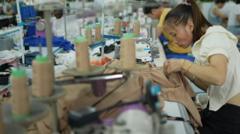The constant hum of sewing machines in the Panyu neighborhood of Guangzhou is a reminder of the relentless pace of the fast fashion industry, particularly as it relates to Shein, the world's largest purveyor of affordable clothing. Known as "Shein village," this area is home to thousands of factories that supply Shein's extensive inventory, including affordable dresses, t-shirts, and swimwear that are shipped to over 150 countries.
Workers in this neighborhood often share harrowing accounts of their grueling work schedules, commonly reporting 75-hour weeks with only one day off per month—a serious breach of Chinese labor laws, according to regulations that require comprehensive rest days and limit working hours. The BBC's investigation revealed similar conditions across multiple factories, highlighting a pattern of excessive overtime that many workers endure to survive in a high-cost environment.
With Shein privately valued at approximately £36 billion ($60 billion) and preparing for a potential IPO in London, the company faces increasing scrutiny regarding its labor practices. Allegations include inhumane working conditions and forced labor, with past reports revealing instances of child labor. While Shein has pledged to improve worker conditions and governance, critics remain skeptical about its effectiveness, especially as the company continues to thrive on low-cost labor.
Shein's business model capitalizes on high-volume production at remarkably low prices. Dresses can be priced as low as £10, which is made possible by the extensive network of local factories and deep discounts. The sheer size of Shein's online inventory, often comprising hundreds of thousands of items, illustrates its success in appealing to budget-conscious consumers globally.
Factory conditions, as observed by the BBC, depict a high demand for efficiency, with workers being paid per piece rather than hourly, often leading to a cycle of competition among employees to maximize their output despite the low pay. Many earn between 4,000 and 10,000 yuan monthly, while the average living wage suggested for the area significantly exceeds their earnings.
Among the workers, sentiments are mixed; some hail Shein as a reliable employer that pays on time, and they view their lengthy hours as a necessary evil in pursuit of economic stability. However, advocacy groups argue that such labor practices promote exploitation, dismissing the efforts to improve conditions as superficial at best. Reports from organizations like Public Eye indicate a systemic issue within Shein's supply chain, illustrating that the pursuit of profit often trumps worker welfare.
Despite operating from Singapore, the majority of Shein's production remains concentrated in China—a country exceptionally suited for rapid garment production given its complete supply chain, from material sourcing to manufacturing. Critics, particularly in Washington, question Shein's labor practices and transparency, emphasizing that continued scrutiny is necessary regarding sourcing practices, particularly concerning cotton alleged to be produced using forced labor in Xinjiang.
Looking forward, Shein's ability to navigate public concerns about labor practices will influence its upcoming strategies, especially as it seeks to bolster its reputation for future investors. Transparency is suggested as an essential step in rebuilding trust, with experts calling for the release of factory lists and clear communication about labor treatment.
The delicate balance between Shein's profitability and the working conditions of its employees remains an ongoing discussion in the realm of fast fashion—an industry often criticized for its low-cost allure at a high human cost. As workers toil late into the night, the prominence of Shein serves as both a point of pride for some and a stark reminder of the harsh realities behind consumer bargains.




















